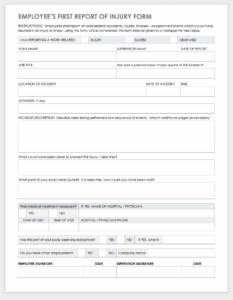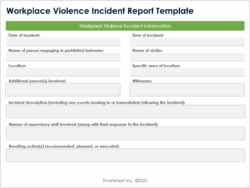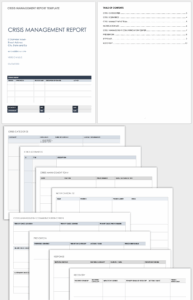Workplace safety is a cornerstone of any successful operation, ensuring that employees can perform their duties without undue risk. Despite best efforts and stringent safety protocols, incidents can sometimes occur. When these events lead to an injury, understanding the circumstances and consequences becomes absolutely vital, not just for the affected individual but for the entire organization. It’s about learning from what happened to prevent it from happening again.
Among the various types of workplace incidents, a “lost time injury” stands out because it involves an employee being unable to return to work for a period after the incident, extending beyond the day or shift the injury occurred. These incidents carry significant implications, from direct costs like medical expenses and workers’ compensation to indirect costs such as lost productivity, morale impact, and potential regulatory scrutiny. Accurate and timely documentation is crucial for managing these situations effectively.
This is where a robust and comprehensive lost time injury report template comes into play. Having a standardized form isn’t just about ticking boxes; it’s about providing a clear, consistent framework for gathering all necessary information following an incident. Such a template ensures that no critical detail is overlooked, facilitating thorough investigations, informed decision-making, and ultimately, a safer working environment for everyone. It serves as an indispensable tool for employers committed to mitigating risks and fostering a culture of safety.
The Indispensable Elements of an Effective Injury Report
Creating a detailed and actionable injury report is not just a formality; it’s a critical step in a continuous improvement cycle aimed at preventing future incidents. A well-designed lost time injury report template acts as your investigative blueprint, guiding you through the systematic collection of facts, observations, and insights. Without a structured approach, crucial details might be missed, leading to incomplete investigations and ineffective corrective actions. The goal is to move beyond simply recording an event to understanding its root causes and implementing sustainable solutions.
The initial sections of any report should focus on gathering fundamental data. This includes precise information about the injured employee, such as their name, job title, and department, alongside specific details about the incident itself—the exact date, time, and location where it occurred. Capturing this data accurately sets the stage for a reliable account of the event. It’s important to be as precise as possible, noting even small details that might later prove significant during the analysis phase.
Following the basic information, a comprehensive incident description is paramount. This section should provide a narrative of what happened leading up to, during, and immediately after the injury. Encourage objective descriptions of observable facts rather than assumptions. Including space for witness statements is also highly valuable, as different perspectives can often shed light on various aspects of the incident. These accounts should be recorded promptly while memories are fresh, ensuring accuracy and detail.
Next, the focus shifts to the injury itself. This includes describing the nature of the injury (e.g., sprain, fracture, cut), the body part affected, and the mechanism of injury (e.g., struck by, fall from height). Details about immediate first aid provided and subsequent medical treatment are essential. Crucially, for a lost time injury, the report must document the estimated duration of absence from work, forming the core definition of a lost time incident. This information helps in assessing the severity and impact of the injury.
Finally, and perhaps most importantly, the template should guide the investigation toward identifying root causes and outlining corrective and preventive actions. This goes beyond just fixing the immediate problem; it seeks to address the underlying systemic issues that contributed to the incident. Follow-up measures and a review date should also be included to ensure that implemented changes are effective and sustained over time, closing the loop on the safety management process.
Key Sections to Include
Leveraging Your Lost Time Injury Report Template for Continuous Improvement
Once an incident report has been thoroughly completed, its utility doesn’t end there. A well-structured lost time injury report template is designed not just for documentation but as a powerful tool for driving continuous improvement in workplace safety. The data collected from multiple reports, when analyzed collectively, can reveal patterns, highlight high-risk areas, or expose deficiencies in existing safety protocols. This aggregated information becomes invaluable for making data-driven decisions regarding safety investments, training programs, and procedural adjustments.
Effective implementation involves more than just having the template; it requires a commitment from management and a clear understanding among employees of its purpose and importance. Regular training on how to accurately fill out the template, who is responsible for reporting, and the timeline for submission ensures consistency and thoroughness. When employees feel confident in the reporting process and understand that their input contributes to a safer environment, they are more likely to report incidents promptly and accurately, even near misses that don’t result in injury but offer critical learning opportunities.
The insights gleaned from these reports should feed directly back into the company’s safety management system. Whether it’s redesigning equipment, implementing new personal protective equipment, or revising job procedures, the findings from each lost time injury report should inform concrete actions. This iterative process of reporting, investigating, analyzing, and acting is what transforms a simple document into a cornerstone of an organization’s proactive safety culture, constantly striving for a workplace free from preventable harm.
A robust framework for documenting incidents, especially those involving lost time, plays a crucial role in not only meeting regulatory requirements but also in fostering a profound commitment to employee well-being. It transforms a potentially negative event into a valuable learning opportunity, driving systemic improvements that safeguard your most valuable assets: your people.
By diligently utilizing a comprehensive reporting system, organizations can move beyond reactive responses to proactive prevention. This ongoing commitment to understanding and addressing the root causes of incidents ultimately cultivates a culture where safety is paramount, ensuring that every employee can return home safe and sound at the end of their workday, confident in their employer’s dedication to their protection.




